Artopia: May 2008 Archives
Some artists make art. Some make icons. Some, like Keith Haring, made both. Haring (1958-90) started out as a guerrilla subway artist. You see, there were all these unsold advertising boards in the subways: blank and all-black, like vertical schoolroom blackboards. He went around inscribing them in white chalk with a joyous repertoire of cartoony outline-figures. Some people pried them off and saved them.
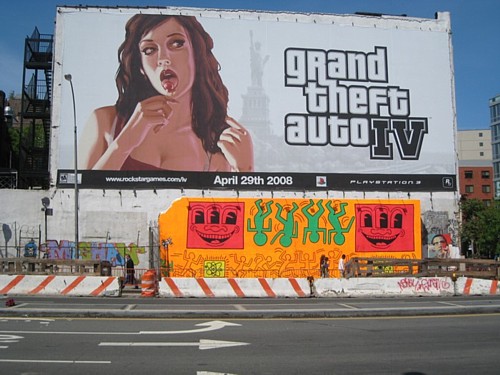 Keith Haring: Houston Street and Bowery Mural, 1986/2008
Keith Haring: Houston Street and Bowery Mural, 1986/2008
Then he went all-color and began to cover the world with his Martian invaders, disco/hip-hop dancers, doggies, howling werewolves, and (my favorite) radiating/radioactive babies. He covered notebooks, hallways, walls, and objects of all kinds -- even the dancer Bill T. Jones. Also canvases, although I don't think canvases were his natural medium. In 1986 he opened his Pop Shop in Soho, where one could get Haring T-shirts, note cards, postcards, skateboards, buttons, etc. Art for the people!
Early on, before he was famous, I sometimes saw him furtively buying magic-markers at my corner newspaper/magazine/stationery store on Second Avenue and Ninth Street, long replaced by some mass-food eatery of no consequence.
Magic markers? Obviously the cause of a graffiti plague. There may have been a law or should have been a law preventing sales of such weapons to teenagers. There was a spray paint law. At this point, Haring was no longer a teenager, but he looked youngish and pleasingly nerdy, like a cross between a School of Visual Arts student and Harold Lloyd.
Unlike Jean Dubuffet (one of Haring's idols and influences), who discovered his doodle-derived L'Hourloupe language late in life, Haring was precocious. He developed his own visual bag of tricks when he was still an art student: a graphic language of exuberant, cartoony figures that could be applied to any surface. But unlike Mayan or Egyptian pictograms, Haring's icons are immediately readable.
The recently recreated Haring mural (courtesy Goldman Properties, Deitch Projects, and the Keith Haring Foundation, at Houston and Bowery in Manhattan to Dec. 21, 2008) features his atomic logo, dancing boys, and a funhouse man and his twin. The Day-Glo colors almost guarantee fun-fun-fun. But, wait a minute, are the figures dancing or running and skidding? What is amusing about the symbol for atomic energy? Particularly one with radiating lines? Aren't the grinning funhouse twins with three eyes more than a bit creepy? Or are they just dopey? And why are the chartreuse dancers upside down? Dancing on the ceiling, I guess, in some coloring-book nursery of the mind.
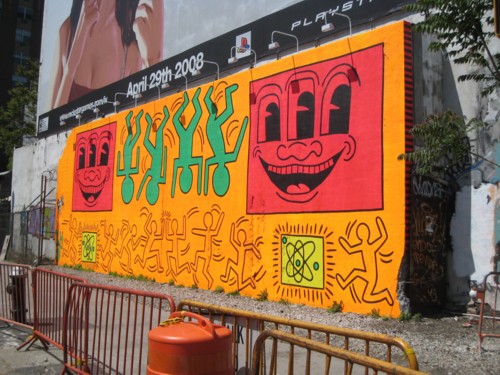
Haring: Houston Steet and Bowery Mural, 1982/2008
Here we have to revert to Infantilism - perhaps a subdivision of Pop, but even more insidious. After all, in a consumer world who really wants to grow up? Nostalgia for the nursery seems to be universal, possibly because being a grownup is an expensive, full-time job. In art, when we say the Nanny State we don't mean socialism, we mean the state of Infantilism. Jeff Koons and Takashi Murakami are ace practitioners, and so was Haring, although his work seems not to have been ironic, just meant to please. In that regard, he succeeded.
From his writings (available on the official Haring website) we know he wanted to make art for the public, which is akin to leaping over the art world wall. In the past, according to the modernist myth, this happened only through the good grace or the happenstance of posterity. Haring didn't seem to be searching for spiritual truths, self-knowledge, or even a contribution to the art discipline, goals that sometimes can be awfully pompous and a bit pretentious.
He did, however, have a social conscious, as witnessed by his 1986 Crack Is Whack mural, now scheduled for restoration, and several AIDS awareness artworks.

Haring, Crack Is Whack, 1986
On the other hand, if young men dancing, howling werewolves, and radioactive babies suit your mood - as they do mine when I am feeling particularly cheerful or need to be rescued from a funk - then Haring is your guy.
And it does occur to me that all the Infantilists are men. Why? Because women associate art with moving forward into self-determination and maturity rather than with a retreat to the romper room?
Furthermore, does Infantilism have a history prior to Haring, back beyond Dubuffet to Joan Miró at his best and Salvador Dalí at his worst? Closer in time, an old-fashioned shrink might have seen Abstract Expressionism as Infantilism, since pushing paint around can be like playing with excrement. Thus, wonder of wonders, we can link Koons, Murakami, and Haring to Jackson Pollock and Willem de Kooning.

How to use the Artopia Archive. Scroll down past "Monthly Archives" and then "Categories" for a list of actual headlines.
For an Automatic Artopia Alert for new posts contact: perreault@aol.com
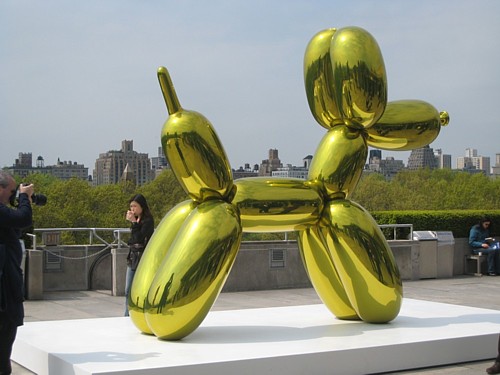
Through the Roof
"Jeff Koons on the Roof" at the Metropolitan Museum (to Oct. 26, 2008) consists of only three sculptures: Balloon Dog (Yellow), Coloring Book, and Sacred Heart (Red/Gold). The Met's mingy roof garden, symptomatic of its less than stellar commitment to contemporary art, could hardly showcase more.
Because, as far as I know, there is no career-breaking or career-affirming retrospective on the boards for Koons, Inc., I thought I'd allow this tiny sampling to permit some musings on the master of crowd-pleasing provocations.
Koons has not been fully anointed by MoMA or the Whitney -- the Guggenheim simply doesn't count for much now -- but he simply will not go away. Although he has been showing irritating work since the '80s, I have not given him much attention either. No matter how charming or outrageous his efforts, I thought the odd relationship between commercialism and its critique overwhelmingly favored the former. Now I am not so sure.
A cursory review reveals some "autobiographical" works even beyond his notorious riffs on his marriage to Cicciolina, an Italian porn star (and former member of the E.U. parliament). Fake movie ads featuring himself and his better half were upstaged by the Koons couple's Kama Sutra in glass. But there's also an academic self-portrait bust in white marble. There may have been something deeper than publicity involved, but perhaps publicity is deep enough.
An art that is all surface deserves to be judged by that surface, and therein, as it were, Koons wins, for in some sense the artworks are merely the props that prop up the real artwork -- which is Koons himself. Here's a test: if you Google him for images, in comparison to his contemporaries there's a higher percentage of images of the artist himself. For instance, I found only one picture of Richard Prince, but the Koons grin is Google-biquitous. Oh, how Andy Warhol. Well, not exactly. Unlike Warhol, Koons has banned death. And drugs.
Furthermore, although one can say "Andy" (or "Jackson" or "Jasper") and everyone in the art world will know who you mean, Koons' first name does not accomplish the same. Oh, the curse of an ordinary forename, as I well know.
Perhaps in consequence, Koons presents himself as eerily clean-cut and the proud father of numerous children. We are also not allowed to forget that he wins when it comes to employees: 95 of them, proclaims the vulgar Met handout. That beats Andy, who, aside from the superstars lounging about, usually made do with poet Gerard Malanga. Koons outdoes everyone. We know that Murakami has only 30 studio assistants, which he recently revealed when explaining the anxiety that was at the root of his painting Tan Tan Bo Puking. Oh, the tortures of small-time capitalism. Oh, the responsibilities of running an atelier and keeping everyone busy and paid.
If there is any profundity in Koons, it is hidden deep inside a sunny disposition (which may be all a put-on) and in his valorization of childhood and childishness. We all know, don't we, about the dark side of the nursery? Me! I am the center of the universe!
In these times, it is fitting that the world's most cheerful artist has ended up producing outsize toys for adults. But here, I admit, what he really may be saying is that this is indeed what art has become: playthings for the rich.
It is no longer a question of how much money you have, manage to give to charity, or what do-good foundations you create. Rather, it's a matter of my toy is bigger than your toy.

More True Confessions of an Art Critic
I almost bought a Koons. Art critics are not supposed to buy art on the grounds that such would be a conflict of interest. On the other hand, we have always been allowed to receive gifts from artists who thereby subsidized the pictorial tomes once issued, which required essays of a sort.
But it was 1985, once the height of no-holds-barred commercialism and I was on an art criticism sabbatical; plus, although it is not much of an excuse, I was truly smitten by the Koons underwater basketball piece called One Ball Total Equilibrium Tank. I liked the bronze Aqualung and the bronze Lifeboat also on display, but thought it seemed to present maintenance problems, the Tank outranked the bronzes in sheer meaninglessness.
Come to think of it, the aqualung and lifeboat meanings might be as close to meaninglessness as the suspended basketball. A bronze aqualung and a bronze lifeboat are as useless as any formalistically Greenbergian painting and could equally not allow you to breathe underwater or save your life. The only difference is that Koons' gestures can be construed as satirical. And the basketball in equilibrium just might refer to the celebrated equilibrium between push and pull promoted by the minor Abstract Expressionist Hans Hofmann.
But the more I thought about it, a basketball mysteriously suspended underwater was truly meaningless, and thus appealing. The price was modest enough for my minuscule budget (if I went without lunch for the next three years). So I had what I now like to call my Lil Picard moment.
I have mentioned before my old friend Lil -- critic, journalist, artist, self-proclaimed Weimar Republic coffeehouse girl -- circling a Midtown block trying to decide if she should buy a $100 Jackson Pollock the opening day of his first show at the Betty Parsons Gallery, deciding not to, and then regretting it the rest of her life, doomed in her mind and probably in the afterlife to endlessly circling that Midtown block. Here I was at a different time in art history, circling an East Village block. If I had purchased that Koons, I'd now be on easy street.
But the real reason I was cool to Koons was that I saw him as a Pop artist manqué. Hadn't Pop Art been dropped and superceded? You know, around the time Koons was in high school?
Pulling Braids
Since them I have corrected my addiction to the academic model of art history: a straight line, rising or not, but a straight line nonetheless. And always irreversible, like the child's version of evolution, whether biological or theosophical. A dialectical model is better, but still not complicated enough. To build a better art history, one must build a better model.
I discovered the braid. Picturing a braid allows for exits and returns, for occultations and reappearances, and permits three or more strands to interact -- whatever you allow the strands to represent. That's a much better model than my previous attempt to use the metaphor of a critical (or market) spotlight, picking out specific artworks on a stage crammed with art.
But hadn't Warhol already said enough? Wasn't his ambiguous compounding of commercialism and its critique exhaustive? Well, in spite of the Conceptual Art moment, commercialization went on. And on.
And so did Pop, snaking its way into the future. Marco Livingstone's Pop Art, A Continuing History (Abrams, 1990) got it right. First of all, from his British perspective, he sees Pop even at the beginnings as international. And then he moves it along from the '60s through Neo-Pop in the '80s, and along the way includes not only Errò and Fahlström, but also Richter and Polke, and ends up with Koons and Bickerton and the appropriationists. But his view does not have enough "theory" to convince those who still have a concealed need for art to be structured upon replacement value.
To this day, pure Conceptual Art suffers from inadequate art-history coverage, because non-object art is difficult to sell. How, at the auction podium, do you hold up a cubic foot of air? How do you impress your paddle rivals with a sentence written on a cloud? Or a verbatim dictionary definition?
In the '80s, the return to painting and sculpture, so-called, was the return to product.
I was accustomed to the radical climate of the late '60s and early '70s that offered a new art style every 15 minutes. But that was over. The new is not permanently new.
Forthwith, along came Koons to reiterate the Warholian question: Can satire also be what it is satirizing? Can sarcasm be sentimental? Can the sentimental be sarcastic? Can making money be a goof on making money? Can making fun of fame make you famous?
Those questions inspire a few of my own:
But isn't art, like poetry and philosophy, about the search for knowledge or truth? And if so, why should art be so much more costly than either? Because only that which is expensive survives?
In the meantime, we can start with the three Koons sculptures at, of all places, the Metropolitan Museum of Art.
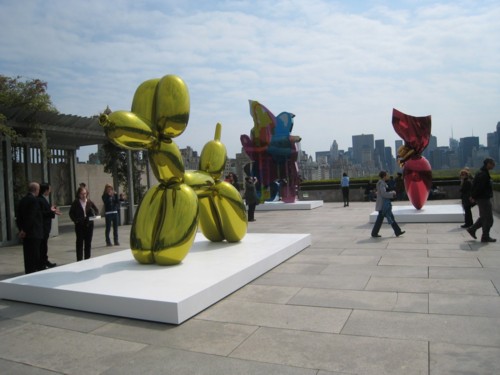
Up on the Roof
When you step out on the roof, there is a "no photography" sign that no one pays any attention to. It was difficult to get a shot of Balloon Dog, Yellow (1994-2000) sans tourists. Singles, couples and groups took turns posing in front of the obscene Koons Dog made out of stainless steel sausages or penises.
So I concentrated on the Sacred Heart (1994-2007), a stainless steel representation of a chocolate heart wrapped in foil, but in spite of its jab at Catholicism, it is a lesser work. Like the Dog, it is an Oldenburgian blowup of a popular object. Still lesser is Coloring Book (1997-2005) -- the coloring book outline of Winnie-the-Poo's Piglet, with scribbled-in colors. Unlike Dog and Heart, the Piglet is not singular enough to have much impact, though it could pass for a good joke about abstract painting.
So here's another question: How come almost anyone can tell that these blowups are not Oldenburgs?
Claes Oldenburg is never nasty. And there is always a little something that lets you know that you are not looking at a straightforward blowup, some kink or glitch. On the other hand, a Koons is bland, seems unmediated and immaculate, as if untouched by human hands -- which is not really the case. We have a friend whose artist-nephew is thrilled to work in the Koons studio, polishing stainless steel, for hours and hours, day after day.
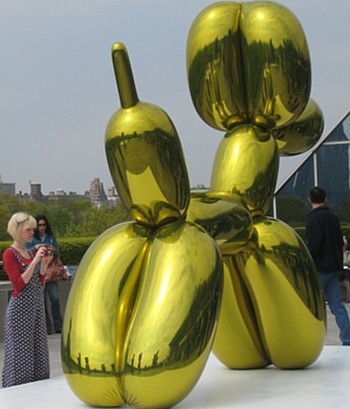
Vote With Your Camera
While waiting for the Balloon Dog to be clear of tourists exposing frozen smiles, it dawned on me that the number of students and other art fans posing in front of the Dog indicated that this was the hands-down favorite. It is iconographic. It is photogenic. And somehow it says: I am here. I am in New York on the roof of the Metropolitan Museum of Art. No one, I swear, was having his or her picture taken in front of the Sacred Heart (I did imagine that some nuns might appear at any moment), and no one was posing in front of Piglet.
As everyone knows, the snapshot is a better voting mechanism than the museum postcard. Postcard images are preselected.
The public and I agree that Balloon Dog is the winner.
But it took me awhile, because...
I once had an art administrator friend who was dating a clown. He was actually an actor who did clown work to pay the rent, specializing in making balloon figures at kiddie birthday parties in Ringling Bros. drag. I thought he was both handsome and quite jolly. His good looks notwithstanding, my art administrator friend and her Bozo soon parted ways. She didn't like it when, out of clown drag and back in mufti, he would sometimes wear his clown shoes in the streets of Soho -- to embarrass her, she thought. I fantasized that perhaps it was because he had really big feet and his clown shoes were more comfortable than his wingtips or his sneakers.
Once I rose above that particular memory, I was able to look at Balloon Dog for what it really was: a beautiful monument to bad taste.
* * *
Along with Balloon Dog, here are other nominations for an exhibition of Koons' Greatest Hits:
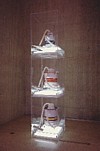
New Shelton Wet/Dry Triple-Decker, 1981.

Three Balls 50/50 Tank, 1985

Bunny, stainless steel, 1986.

Michael Jackson and Bubbles, porcelain, 1988.

Made in Heaven, billboard, 1989.
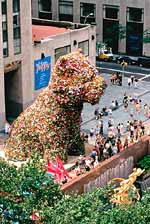
Puppy, flowers, moss, etc. 1992. Displayed at Rockefeller Center, 2000.

Balloon Bunny, inflatable, Macy's Thanksgiving Day Parade, 2007.
And the gigantic upside-down train commissioned for the entrance to the L.A. County Museum of Art? We'll have to wait and see.
For an Automatic Artopia Alert when a new essay is posted, contact Perreault@aol.com
AJ Ads
AJ Blogs
AJBlogCentral | rssculture
Terry Teachout on the arts in New York City
Andrew Taylor on the business of arts & culture
rock culture approximately
Laura Collins-Hughes on arts, culture and coverage
Richard Kessler on arts education
Douglas McLennan's blog
Dalouge Smith advocates for the Arts
Art from the American Outback
For immediate release: the arts are marketable
No genre is the new genre
David Jays on theatre and dance
Paul Levy measures the Angles
Judith H. Dobrzynski on Culture
John Rockwell on the arts
Jan Herman - arts, media & culture with 'tude
dance
Apollinaire Scherr talks about dance
Tobi Tobias on dance et al...
jazz
Howard Mandel's freelance Urban Improvisation
Focus on New Orleans. Jazz and Other Sounds
Doug Ramsey on Jazz and other matters...
media
Jeff Weinstein's Cultural Mixology
Martha Bayles on Film...
classical music
Fresh ideas on building arts communities
Greg Sandow performs a book-in-progress
Exploring Orchestras w/ Henry Fogel
Harvey Sachs on music, and various digressions
Bruce Brubaker on all things Piano
Kyle Gann on music after the fact
Greg Sandow on the future of Classical Music
Norman Lebrecht on Shifting Sound Worlds
publishing
Jerome Weeks on Books
Scott McLemee on books, ideas & trash-culture ephemera
theatre
Wendy Rosenfield: covering drama, onstage and off
Chloe Veltman on how culture will save the world
visual
Public Art, Public Space
Regina Hackett takes her Art To Go
John Perreault's art diary
Lee Rosenbaum's Cultural Commentary
Tyler Green's modern & contemporary art blog
